Looking to get started in road cycling with an entry-level road bike?
You’re on the right page.
I’ll show you the popular models under $1,000 among road cyclists, as well as what you should consider and expect before buying.
Things like frame materials, geometry, and groupsets will play an important role in your decision-making.
If your budget allows, you want to consider better-specced road bikes such as those around the $2,000 or even $3,000 price range. Or if you’re tight on budget, you can also consider road bikes under $500.
A Quick Glance : Our Favorite Road Bikes Under $1,000
| Bike Model | Frame | Groupset | Weight |
|---|---|---|---|
| Trek Domane AL2 | Aluminum | Shimano Claris, 8 Speed | 10.0 kg / 22.0 lbs |
| Giant Contend AR3 | Aluminum | Shimano Sora, 9 Speed | 10.3 kg / 22.7 lbs |
| Salsa Journeyman | Aluminum | Shimano Sora, 8 Speed | 11.6 kg / 25.6 lbs |
| Co-op Cycles ADV 2.1 | Aluminum | Shimano Claris, 8 Speed | 10.0 kg / 22.0 lbs |
| Raleigh Merit 2 | Aluminum | Shimano Sora, 9 Speed | 10.6 kg / 23.3 lbs |
| Fuji Jari 2.3 | Steel | Shimano Sora, 9 Speed | 13.0 kg / 28.6 lbs |
| Roll AR1 | Aluminum | SRAM Apex, 10 Speed | 10.4 kg / 23.0 lbs |
Trek Domane AL 2
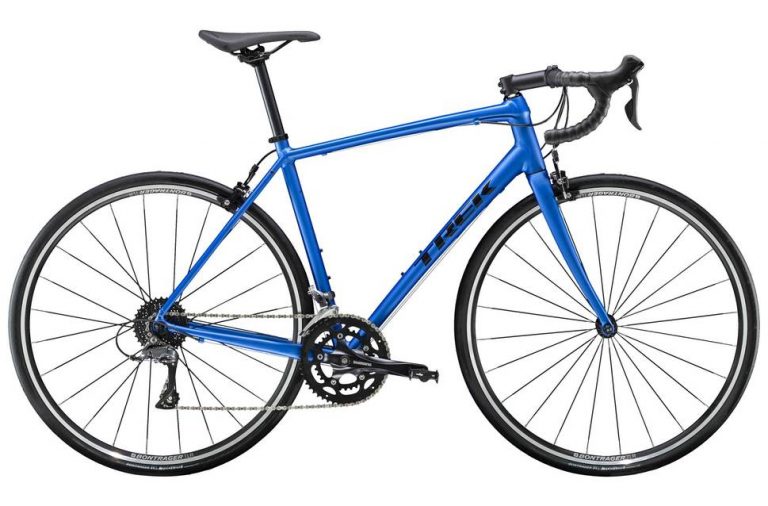
- Frame : Aluminum
- Groupset : Shimano Claris, 8 Speed
- Weight : 10.0 kg / 22.0 lbs
Trek has been manufacturing frames since the mid-1970s. Over the years, they’ve become known for their high-quality bikes.
The Trek Domane AL 2, is a budget road bike that features a lightweight aluminum frame. The frame’s geometry is designed for endurance with a more upright position, while a full carbon fork helps absorb shocks. There are also mounts for rack and fender add ons.
The Domane uses Shimano’s first-tier entry-level components, Claris R2000, for the drivetrain, shifters, and brakes. One nice feature of the Domane is shifters integrated with the brake levers, meaning your hands will never have to leave the bars. The wheels and handlebars are also from Bontrager.
The frame plus components give the Domane a manageable load of 10 kg.
Giant Contend AR 3
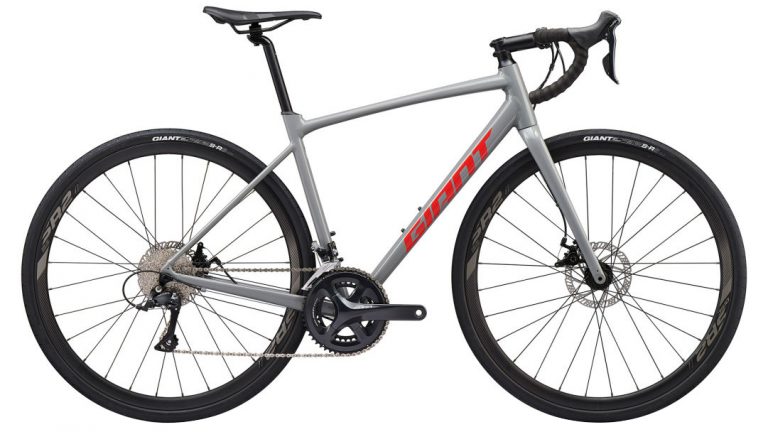
- Frame : Alloy
- Groupset : Shimano Sora, 9 Speed
- Weight : 10.3 kg / 22.7 lbs
Giant bills the Contend AR3 as your first true road bike.
And for an entry-level bike, the Giant AR 3 is pretty impressive. It comes specced with Shimano’s second-tier component group, the Shimano Sora. The rear cassette offers greater versatility than other entry-level bikes with 9 speeds.
An aluminum frame keeps this bike lightweight, while the hybrid composite carbon forks dampen road vibration. Giant describes its frame geometry as balanced for both aggressive riding and endurance.
Mechanical disc brakes provide plenty of stopping power, which is a nice feature on the Giant AR 3, something you don’t always get on entry-level road bikes.
Salsa Journeyman
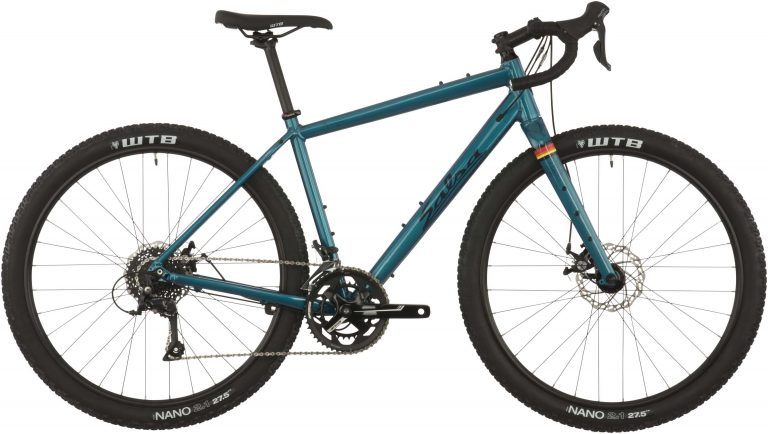
- Frame : Aluminum
- Groupset : Shimano Sora, 9 Speed
- Weight : 11.6 kg / 25.6 lbs
The Salsa Journeyman is built with journeying in mind.
Components are full Shimano with an FSA crankset and 8-speed rear cassette. And, while Claris may be at the lower end of Shimano’s groupsets, it offers reliable shifting and includes the same integrated brake and gear lever setup found on Shimano’s higher-end components.
The 1.5” WTB Riddle Comp tires offer enough tread for off-road excursions on rails-to-trails paths but enough roll for efficient road riding. And if those tires aren’t beefy enough, the Journeyman has enough clearance to accommodate tires up to 2” wide.
There are some nice upgrades for the Salsa Journeyman at the sub $1,000 price point. This includes flat-mount disc brakes and full-length internal cable routing.
Co-op Cycles ADV 2.1
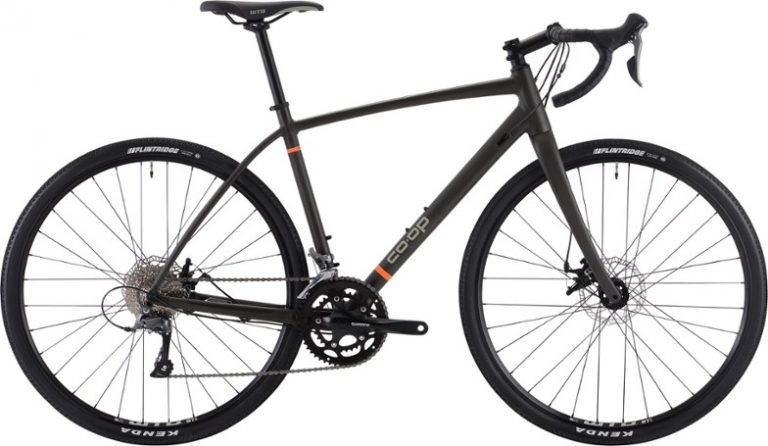
- Frame : Aluminum
- Groupset : Shimano Claris, 8 Speed
- Weight : 10.0 kg / 22.0 lbs
Keeping in line with its focus on outdoor adventures, REI’s Co-op line was branded as a trail first approach.
The Co-op ADV 2.1 is designed to be ridden comfortably both on and off paved surfaces, giving you a very versatile, entry-level road bike.
A double-butted aluminum frame with a carbon fiber fork keeps the weight down to 10 kg, while the compact 50/34T gearing gives you sufficient gears to ride fast on the flats and also go up steep climbs. For increased comfort and confidence riding off-road, it’s equipped with disc brakes and wider 35mm tires in which you can run lower tire pressures.
And this wouldn’t be a bike put out by REI if it wasn’t built for adventure. The Co-op ADV 2.1 has plenty of mounting points for frame bags and racks.
Raleigh Merit 2
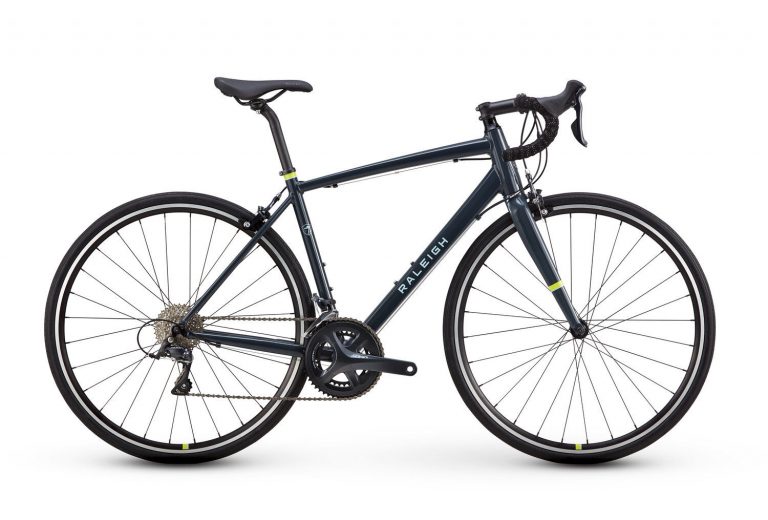
- Frame : Aluminum
- Groupset : Shimano Sora, 9 Speed
- Weight : 10.6 kg / 23.3 lbs
Once a standout with pro racers, Raleigh now focuses on producing youth, mountain, and road bikes for recreational use.
The Raleigh Merit 2 is a road bike with endurance riding in mind. Its endurance geometry keeps you in a more upright position, which makes it better suited for taking on loose gravel and dirt.
Components are all Shimano Sora with a 9-speed rear cassette and a compact 50/34T front chainrings that will get you through some of the steepest climbs. An aluminum frame keeps the bike’s weight in check while making for a responsive ride.
The Raleigh Merit 2 is a great versatile option for those wanting to take on the roads but still in need of some moderate off-road capability.
Fuji Bikes Jari 2.3
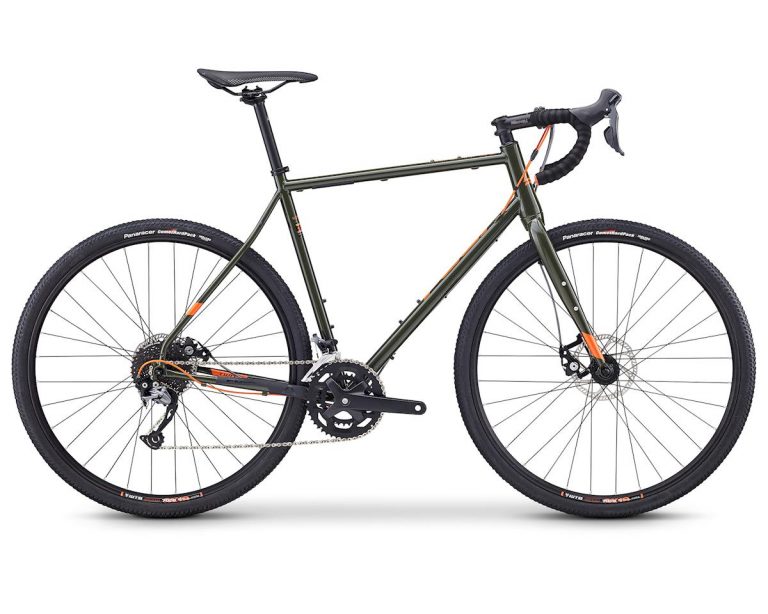
- Frame : Aluminum
- Groupset : Shimano Sora, 9 Speed
- Weight : 13.0 kg / 28.6 lbs
Fuji Bikes, founded in Japan in 1899, takes its name from the famous mountain of the same name. The company’s founder saw the mountain as a symbol of strength and endurance.
Well, strength and endurance are exactly what you can expect from the Jari.
Proving that steel-frame bikes are not a relic of the past, the Fuji Jari 2.3 is a formidable entry-level road bike that is also versatile enough to take things off-road. This bike’s chromoly frame is tough enough to take on not just paved surfaces, but also gravel roads.
It even has plenty of frame mounts for bikepacking. Components include a mix of Shimano’s entry-level road and mountain bike components; Sora brakes, shifters, and front derailleur, and an Alivio rear derailleur.
A 9-speed rear cassette offers plenty of gear options while extra-wide road tires provide off-road stability. At nearly 13 kg, this is also one of the heavier bikes on the market.
Roll Bicycles A1R
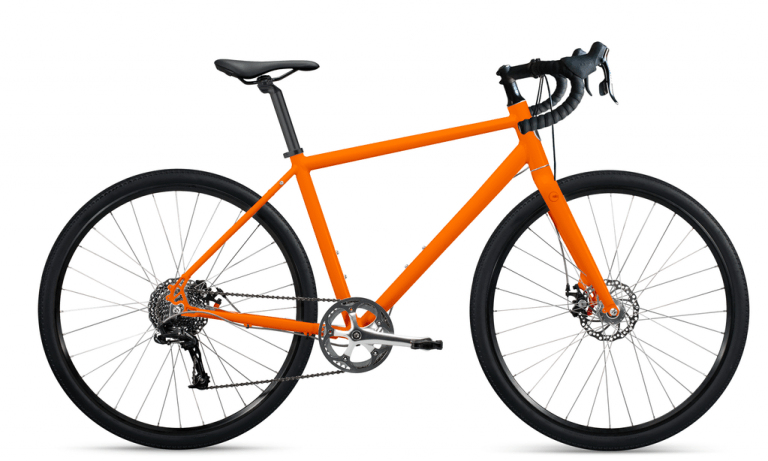
- Frame : Aluminum
- Groupset : SRAM Apex, 10 Speed
- Weight : 10.4 kg / 23.0 lbs
The trend towards bikes that can effectively handle both paved and off-road surfaces continues to spur the development of more and more adventure bikes.
Enter the A1R Adventure Road bike from Roll Bicycles.
Roll’s take on the adventure bike is a balanced mix of a road bike and gravel bike. The frame is lightweight double-butted aluminum for durability and stiffness. Internally routed cables keep brake and shifting lines from getting in the way.
While Roll goes with standard road drops, it opts for a short reach, creating a more comfortable upright riding position for long touring rides. The full SRAM Apex drivetrain leans more towards offroad needs with a 10-speed 11-36T rear cassette and a single 34T front chainring. While this may feel limiting on paved flats, it provides plenty of options for off-road climbs.
What to Expect in An Entry Level Road Bike
With so many options out there when it comes to road bikes, determining which bike is the right first purchase for you can be more than a bit overwhelming.
- Steel or aluminum?
- What’s the difference between Shimano Tiagra and Shimano Sora?
- How aggressive should the frame geometry be?
I’ll cover these questions in the section below.
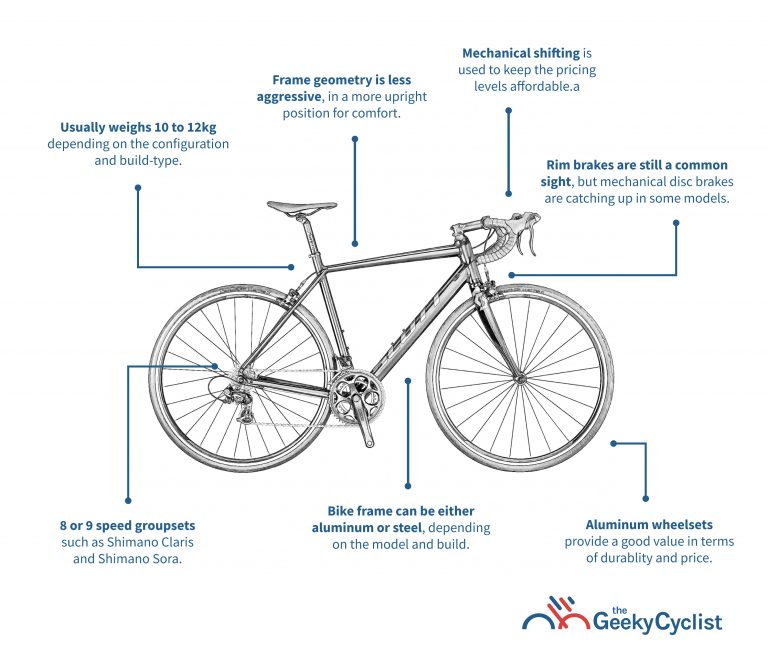
1. Frame Materials
For budget road bikes that cost less than $1,000, you have two options to consider,
- Steel
- Aluminum
Unfortunately, a carbon frame is out of reach at this price range.
The biggest advantage of aluminum is its weight. Aluminum is simply lighter than steel, which means less weight to haul and a faster bike that is easier to handle. Steel, in comparison, is sluggish.
Steel is king when it comes to strength and durability. Whereas aluminum is brittle, steel frames such as Fuji Jari are malleable. They will rarely fail and will bend long before they will break. Steel’s relative flexibility also makes for a more comfortable ride as it will better absorb road shocks than aluminum.
Read More : Steel vs Aluminum Bikes : Which is Better?
2. Frame Geometry
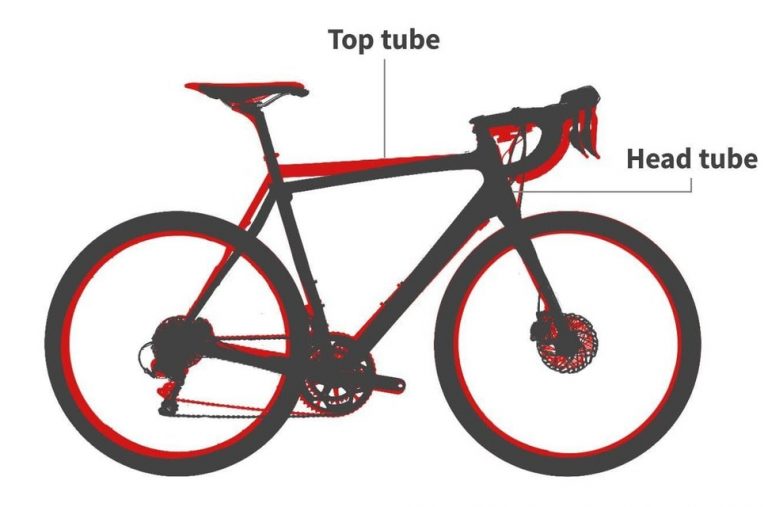
Frame geometry refers to the shape of your bike’s frame.
This includes everything from the length of the tubes, the angles at which they connect, and the height of your handlebars. All of these factors determine how your body fits on the bike.
Frames that are designed for endurance riding will put you in a more upright position, which generally makes riding more comfortable.
For example, the Salsa Journeyman is designed for long-distance riding in mind.
Frame geometry that tilts more to the racing side of road cycling will put you into a more aggressive, lower position that offers better performance but also makes for a less comfortable ride, especially over long distances.
Read More : 5 Things to Know Before Getting A Bike Fit
3. Groupsets
Groupsets make up the drivetrain, shifters, and brakes on a road bike.
When it comes to groupsets, you have three main component manufacturers;
- Shimano
- SRAM
- Campagnolo
You’ll typically only find Campagnolo, or Campy for short, on higher-end bikes while Shimano and SRAM make components for both high-end and entry-level bikes.
Shimano is by far the largest of the three. These manufacturers offer their components in tiered groupsets that range from novice to pro racer.
Shimano’s entry-level groupsets include their Claris, which is at the lowest tier, followed by Sora and Tiagra.
Groupsets in higher tiers are lighter and offer better performance. They also cost more.
Read More :
That said, when purchasing a road bike, you’ll notice that bike manufacturers and brands often mix these groupsets to keep costs down. You might find an entry-level bike with a Sora front derailleur and a Tiagra rear derailleur, for example.
You’ll typically see entry-level bikes equipped with 8, 9, or 10-speed options. This refers to the number of gears in the rear cassette.
For instance, the Giant Contend AR 3 is 9-speed while the Trek Domane and Salsa Journeyman are 8-speed.
What’s the difference?
Generally speaking, when cycling on hilly terrain, the more gears you have, the easier it is to maintain a consistent pedaling speed or cadence. More gears also mean smaller jumps between each gear, allowing for a more consistent cadence.
4. Total Weight
One characteristic you’ll hear a lot about if you spend enough time cycling is the weight.
Because entry-level road bikes are outfitted with heavier components, wheels, and frames, they will typically weigh above 8.5 kg.
Most entry-level bikes such as the Trek Domane AL 2 and Giant Contend AR 3 weigh in at around 10 kg with steel frame bikes weighing upwards of 12 to 13 kg.
Author Recommended Reads

